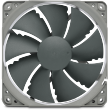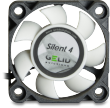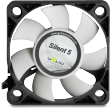Arctic F12 Pro 3-pin 120mm Rear Case Fan Discontinued | |
| More variations available Show | |
Arctic Cooling Arctic F12 Pro 3-pin 120mm Rear Case Fan
A standard 3-pin version of Arctic’s exceptional case fans.
The ARCTIC F9 Pro is exceptionally quiet and cost-effective. Thanks to the patented fan holder and vibration absorption design, these fans are whisper quiet during operation. They are ideal for any cases including HTPC systems.

Why the ARCTIC F Pro fans are quieter than the others?
Over the years, ARCTIC COOLING has built excellent reputation for producing quiet case fans, and the ARCTIC F Pro fans are no exception. The patented vibration absorption is the key to keep the ARCTIC F Pro fans outperform other standard case fans on the market. This sophisticated feature absorbs vibration caused from spinning, offering quiet and stable operation.
User-friendly installation and long service life
Installation couldn’t be easier. Users can mount the ARCTIC F Pro fans on the PC case by the four screws provided. Alternatively, these fans can be installed with screwless mounting mechanism provided in the chassis. Long service life is another advantage of this fan series. Fluid dynamic bearing reduces rotation friction and seals the lubricant precisely in the bearing. As a result, the ARCTIC F Pro fans are highly durable case fans for heavy users.
Features
- Best noise-performance ratio
- Patented fan holder eliminates vibrations
- Patented vibration absorption
- Fluid dynamic bearing extends service life
- Compatible with screwless mounting
| Specifications | Arctic F12 Pro |
|---|---|
| Dimensions | 120 L x 120 W x 34 H mm |
| Rated Fan Speed | 1500RPM (3-pin) |
| Air Flow | 57 CFM / 96.8 m3/h |
| Noise Level | 0.5 Sone (approx 23.5 dBA) |
| Weight | 140 g |
| Bearing | Fluid Dynamic Bearing |
| Warranty | 72 months |
| Specifications | Arctic F12 Pro |
|---|---|
| Dimensions | 120 L x 120 W x 34 H mm |
| Rated Fan Speed | 1500RPM (3-pin) |
| Air Flow | 57 CFM / 96.8 m3/h |
| Noise Level | 0.5 Sone (approx 23.5 dBA) |
| Weight | 140 g |
| Bearing | Fluid Dynamic Bearing |
| Warranty | 72 months |
Customer Reviews
The temperature falls!
May appear a very simple observation, but the temperature on both the MB and the processor runs circa 10 degrees lower than before i changed to this fan. surprisingly low noise level when considering the temperature difference. I have just ordered a second for my other machine!
Personal favourite
I’ve just replaced some L12 model fans (no PWM, previous model) with these. Under normal operation (I estimate at approximately 50% speed) they are no louder than the L12. At full speed they are louder, but with the higher fan speed (1500RPM) they are also pushing more air. Nice long cable, seem well made and they are cheap to boot! I don’t think you can beat them if you’re on a budget, or just need that one more fan. Perhaps some of the more expensive fans are quieter, but these beat everything I’ve tried. Arctic Cooling is definitely my personal favourite.
Product Resources
FAQ
How do I measure fan size?
The size of fan you need will generally be determined by the size of the fan fitting position in your PC case. The sizes of all the fans on our website are shown as measured along any one of the fan’s four sides, NOT the distance between the fan’s screw holes! Our most popular fan size is 120mm, followed by 80mm. This isn’t really dictated by customer preference, but more by recent designs of PC cases.
As for the thickness (depth) of the fan, generally 25mm (1 inch) is by far the most common depth, although smaller fans can have shallower depths such as 15mm or even 10mm. All our fans are 25mm thick unless otherwise stated. If you have any questions about which fan you should order, please don’t hesitate to get in touch.
If you know the distance between the fan mounting screw holes but don’t know what fan size to order, please see the following table. Note that the mounting hole measurements shown below are taken horizontally or vertically between the holes and not diagonally.
Screw hole spacings and fan sizes
Space Between Screw Holes Fan Size 32mm 40mm 40mm 50mm 50mm 60mm 60mm 70mm 72mm 80mm 83mm 92mm 105mm 120mm I received a small cable (resistor) with my fan; what is it for?
The resistor cable (also called Ultra Low Noise or ULN cable) is designed to allow the fan to run slightly slower for even quieter operation. The benefit in lower running noise is significant. Although the airflow will be reduced slightly, this usually has minimal effect on PC temperature. We would generally recommend using the ULN resistor cable for best results in almost all circumstances.
How can I tell which way the air blows through the fan?
Hold the fan so that the round fan sticker is facing you. You are looking at the rear of the fan. When you plug the fan in, the air will be blowing towards you. If you want a fan to act as an air intake, then the fan sticker will be facing the inside of the case. Some fans also have two small arrows moulded into their plastic housing - one arrow shows the direction of airflow, and the other (at 90°) shows the direction of blade rotation.
Is it possible to use a 4-pin PWM fan or CPU cooler with a motherboard which has only 3-pin fan headers on it?
Electrically, there is no problem doing this - the fourth pin on the fan cable is used purely for PWM control and is not needed in order for the fan to run. So you can plug the 4-pin fan connector onto the 3-pin motherboard fan header, leaving the fourth pin not connected to anything. The fan will potentially run at full speed, so if you would like to reduce the speed of the fan you will need to adjust the fan speed setting in your BIOS or use fan control software such as SpeedFan in Windows.
The only other problem to consider is that occasionally, components immediately adjacent to the motherboard fan header can get in the way of the larger 4-pin fan connector, physically preventing connection. This problem also occurs if you try to use an in-line fan speed controller such as the one made by Gelid.
Another avenue to explore is the possibility of using a bay-mounted fan controller. Several models are available now which provide 4-pin fan headers, so this is an easy way to use 4-pin PWM fans in a PC system which has only 3-pin fan headers on its motherboards. When using this method, you may find it necessary to disable any fan warning settings in your motherboard BIOS, since the motherboard may incorrectly believe that its CPU fan has failed when the fan is connected to a fan controller rather than directly to the motherboard itself.
Top Quiet Fans

Noctua NF-P12 REDUX PWM 12V 1700RPM 120mm Quiet Case Fan

Noctua NF-A12x25 PWM chromax.black.swap 12V 2000RPM 120mm Fan

Noctua NF-F12 iPPC PWM 12V 3000RPM 120mm High Performance Fan

Noctua NF-R8 REDUX 12V 1800RPM 80mm Quiet Case Fan

Noctua NF-A12x25 PWM 12V 2000RPM 120mm Ultimate Quality Quiet Fan

Noctua NF-A14 iPPC PWM 12V 3000RPM 140mm High Performance Fan

Gelid Silent 4, 40mm Quiet Case Fan

Gelid Silent 5, 50mm Quiet Case Fan

Noctua NF-A14 PWM chromax.black.swap 12V 1500RPM 140mm Fan

Noctua NF-A14 PWM 12V 1500RPM 140mm Premium Quality Fan

